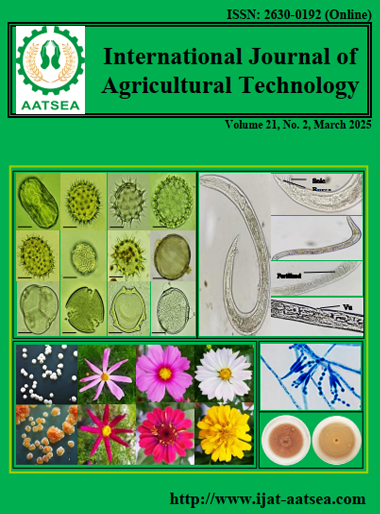Forming packaging from durian husk fiber using modified starch and cassava starch
Main Article Content
Abstract
The formation of packaging from durian husk fibers using modified starch and cassava starch as binders through a heat baking process was analyzed for physical, chemical quality, and shelf life. The results showed that packaging made from durian husk fibers presented a good physical appearance, including strength, hardness, flexibility, and brightness. Packaging formed with cassava starch provided better oil, water resistance, and hardness than modified starch. The water and oil resistance values were 9.2-125.5 sec/ml and 25.8-85.8 sec/ml, respectively. The hardness of the packaging is 0.90-0.93 kg/cm2. The chemical composition of the packaging is contained 7.83-7.94 % moisture and 1.42-4.55 % ash. The moisture content of the packaging increased after storage. A 35-day shelf-life revealed no significant difference in color value, with the L*-value decreased (67.96-68.57), the a*-value increasing (3.75-4.21), and the b*-value decreased (18.42-18.99) over time.
Article Details

This work is licensed under a Creative Commons Attribution-NonCommercial-NoDerivatives 4.0 International License.
References
AOAC (2000). Official methods of analysis (20th ed.). The Association of Official Analytical Chemists. Arlington, Virginia.
Kaisangsri, N., Kerdchoechuen, O. and Laohakunjit, N. (2012). Biodegradable foam tray from cassava starch blended with natural fiber and chitosan. Industrial Crops and Products, 37:542-546.
Monteiro, S., Martins, J., Magalhães, F. D. and Carvalho, L. (2016). Low density wood-based particleboards bonded with foamable sour cassava starch: Preliminary studies. Polymers, 8:354.
Nattha, K. (2019). Preparation of oxidized cassava starch using solution plasma process for biodegradable film wrap application. (Master Thesis). Naresuan University, Thailand.
Rompothi, O., Pradipasena, P., Tananuwong, K., Somwangthanaroj, A. and Janjarasskul, T. (2017). Development of non-water soluble, ductile mung bean starch based edible film with oxygen barrier and heat sealability. Carbohydrate Polymers, 157:748-756.
Salgado, P. R., Schmidt, V. C., Molina Ortiz, S. E., Mauri, A. N. and Laurindo, J. B. (2008). Biodegradable foams based on cassava starch, sunflower proteins, and cellulose fibers obtained by a baking process. Journal of Food Engineering, 85:435-443.
Soykeabkaew, N., Supaphol, P. and Rujiravanit, R. (2004). Preparation and characterization of jute-and flax-reinforced starch-based composite foams. Carbohydrate Polymers, 58:53-63.
Tadini, C. C. (2017). Bio-based materials from traditional and nonconventional native and modified starches. In: Starch-based materials in food packaging processing, characterization and applications, Academic Press, pp.19-36.
Waritchon, N., Kunlaorn, P., Jiraporn, S., Komsan, M. and Pramoun, S. (2021). Development of packaging from durian rind fibers by bleached and unbleached fibers. Journal of Science and Technology Mahasarakham University, 40:422-429.
Waritchon, N., Kunlaporn, P. and Khanitta, R. (2022). The effect of modified starch as a binder on the molding of packaging material sheet from durian husk fiber. The 5th ARUCON conference “Krung Kao Rajabhat”, Phranakhon Si Ayutthaya Rajabhat University, Ayutthaya, Thailand, 187 p.
Wilasini, K. (2010). Preparation and utilization of phosphate cross-linked starch. (Master Thesis). Thammasat University, Thailand.


